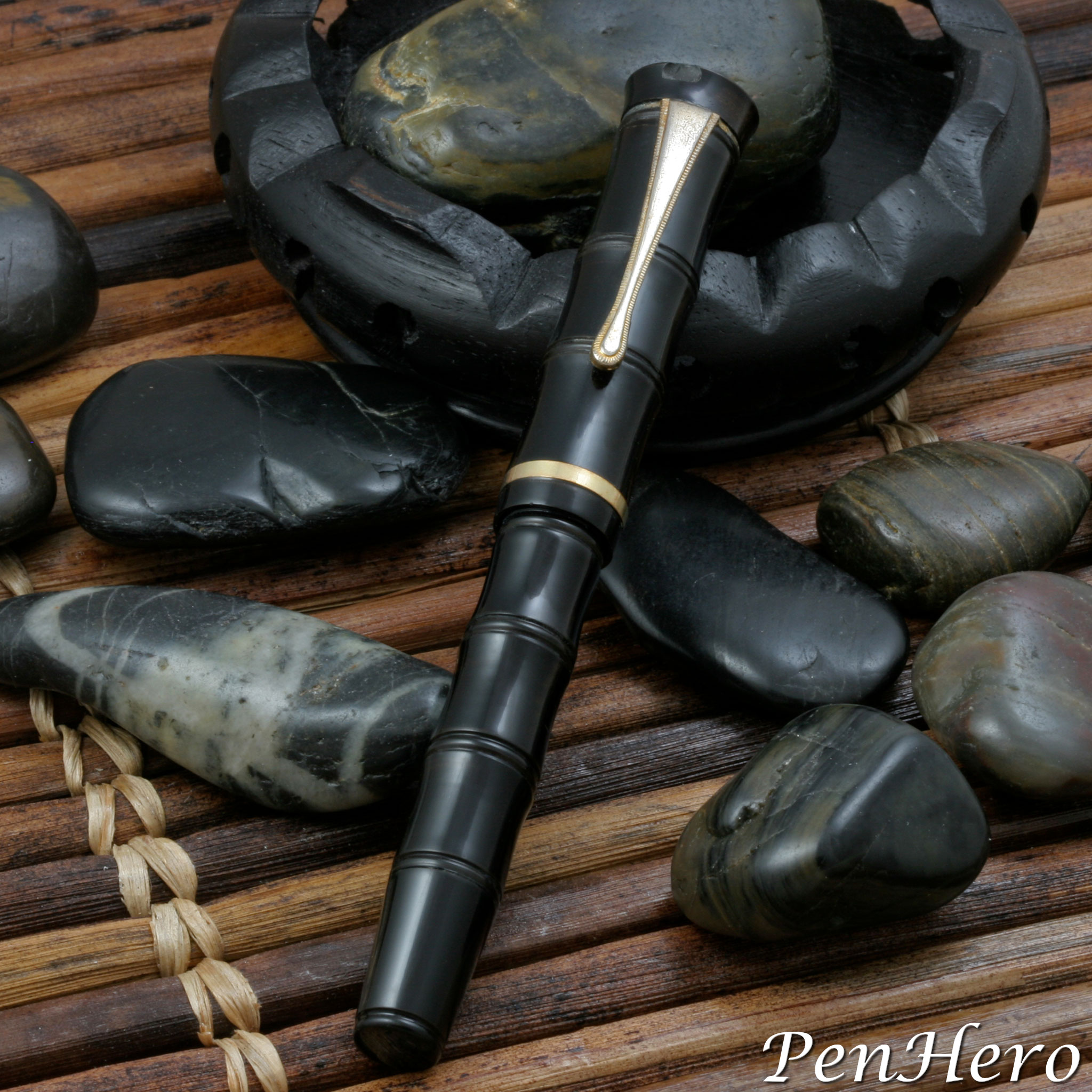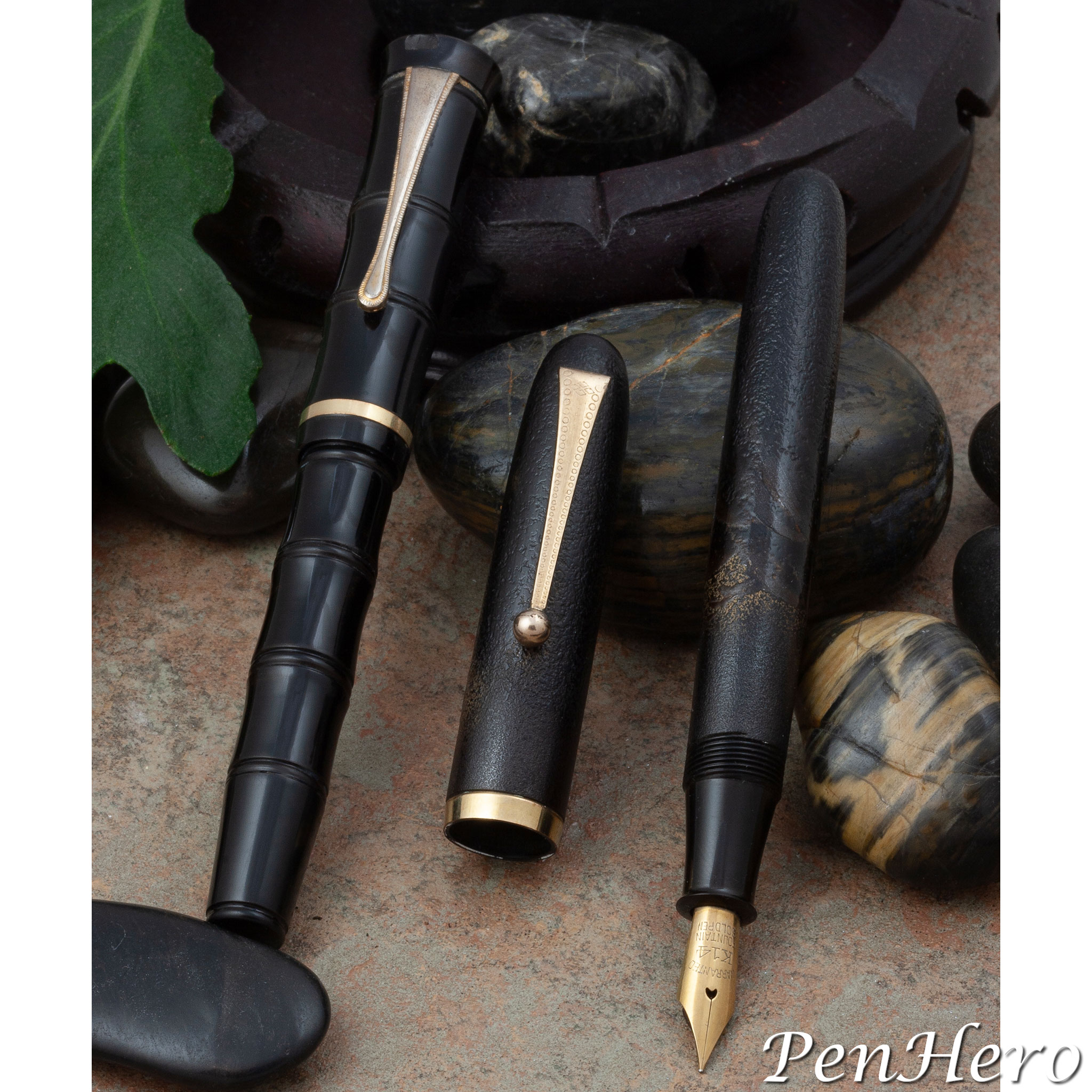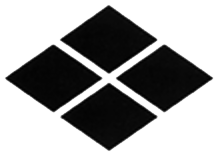Yotubishi (Attributed) Bamboo Look Pen c. 1955-57
by Jim Mamoulides, May 10, 2024
 Yotubishi (attributed) bamboo look pen c. 1955-57
Yotubishi (attributed) bamboo look pen c. 1955-57
Out of the Bamboo Forest
This is a Yotubishi black hard rubber fountain pen with a design carved and then lacquered resembling a shakuhachi 尺八 (Japanese bamboo flute), c. 1955-1957. The Ishi-Shoten Yotsubishi pen company consistently marked their pens on the clip top or cap band with the company’s four diamond logo. In some cases, the clip may be stamped YOTUBISI. Those maker's marks are absent from this example.
A visually identical pen is shown on a page from the 1957 Ishi-Shoten Catalog, appearing on page 113 of Fountain Pens of Japan. The caption says “Chikoku (bamboo look), lacquered hard rubber,” though a literal meaning for chikoku 遅刻 may be slow carving. This pen was photographed for and appeared in the winter 2006 Pennant article "Collecting Japanese Pens" by Stan Klemanowicz and is identified as made by Ishi-Shoten Yotsubishi. The only visual difference between this example and the one shown on the catalog page is the lack of the four diamond logo, so I am calling it "attributed to" Ishi-Shoten Yotsubishi as the pen maker. The pen does not have a nib and feed, so it was only photographed closed.
It's an eyedropper pen with an ink shut-off valve at the end of the barrel. It fills like any other eyedropper pen, by unscrewing the nib section from the barrel and dripping ink into it using a bulb eyedropper. The knob at the end of the barrel is attached to a long rod that extends inside the barrel up to the base of the feed in the nib section. When the knob, which the design cleverly hides, is screwed flush with the end of the barrel, the rod cuts off ink flow to the feed, becoming an ink shut off valve, and making the pen safe to pocket or put down. To write, the knob must be unscrewed slightly, pulling the stopper back from the base of the feed, which allows ink to flow to the nib.
Bamboo Look Carving
The carving technique used to create the bamboo look (ta-ke) is the same as Tuishu-nuri (art carving (of wood) + lacquer coating) applied, in this case, to hard rubber. The result resembles a very small shakuhachi, a type of Japanese flute made of bamboo. The shakuhachi originates from 16th century Japan and is blown from one end, called an utaguchi 歌口 (blowing edge), creating tones in a similar way as blowing across the top of a bottle. The flutes have five finger holes tuned to a pentatonic scale. The Ishi-Shoten catalog page does not refer to the pen as a shakuhachi, but the shape certainly evokes it.
Ishi-Shoten
Ishi-Shoten, also known as Ishi & Co., was established in Tokyo in 1925 by pen maker Yoshinosuke Ishii. Inspired by Pilot's maki-e pens in the 1920s, the small company began by making inexpensive maki-e pens. Ishi-Shoten's four diamond trademark, yotsubishi in Japanese, can be found on the clip top on most of their pens, sometimes on the cap band. Some later pens have clips stamped YOTUBISI. This may seem confusing with three spellings, Yotsubishi, Yotubisi, and Yotubishi, all pronounced the same, but they are all the same company. Fountain Pens of Japan makes the distinction that the company name became Ishi-Shoten Yotsubishi, but the brand name was Yotubishi. The company ceased operations in 1984.
 Yotubishi (attributed) bamboo look pen c. 1955-57 (left) with Yotubishi pen with maki-e decoration of a pond scene with fish (date unknown, c. 1930s)
Yotubishi (attributed) bamboo look pen c. 1955-57 (left) with Yotubishi pen with maki-e decoration of a pond scene with fish (date unknown, c. 1930s)
Pens carved to look like a rod of bamboo are very uncommon. The carving work is very fine and realistic. Unfortunately the pen has some damage on the cap top where a small chunk has been knocked out. To me it adds a bit of natural look to the pen, rather than being a detraction. The only other negative is the lack of nib and feed, which with some searching could be addressed with a period correct replacement. Because of the unusual design and fine craftsmanship, this would be a prized pen in any Japanese pen collection.
References
“Collecting Japanese Pens” by Stan Klemanowicz, The Pennant, Winter 2006, published by the Pen Collectors of America
Fountain Pens of Japan by Andreas Lambrou and Masamichi Sunami, © 2012 Andreas Lambrou Publishers, Epping, Essex, United Kingdom, pages 101-118
Sendai-Tsuishu: Sendai Lacquerware, © 2024 Japanese Traditional Culture Promotion & Development Organization
Shakuhachi, © 2000–2024 The Metropolitan Museum of Art
Interact
Comments on this article may be sent to the author, Jim Mamoulides


